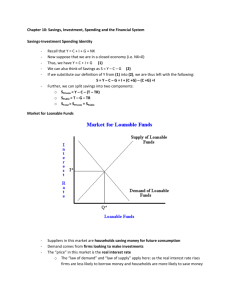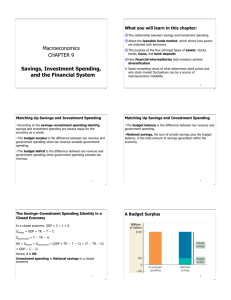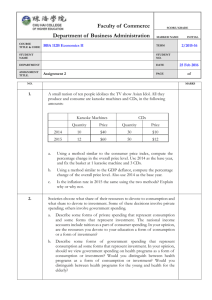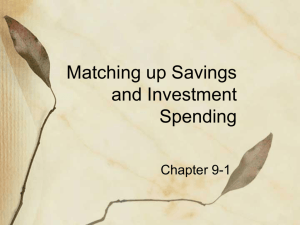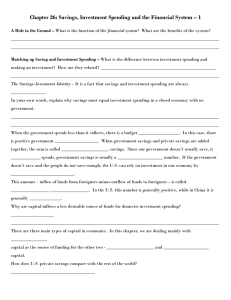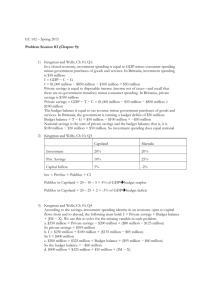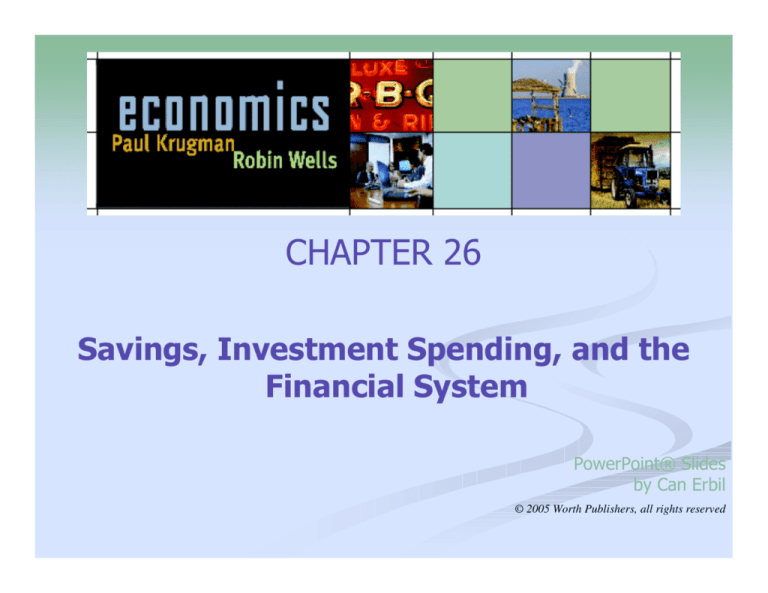
CHAPTER 26
Savings, Investment Spending, and the
Financial System
PowerPoint® Slides
by Can Erbil
© 2005 Worth Publishers, all rights reserved
What you will learn in this chapter:
The relationship between savings and investment spending
About the loanable funds market, which shows how savers
are matched with borrowers
The purpose of the four principal types of assets: stocks,
bonds, loans, and bank deposits
How financial intermediaries help investors achieve
diversification
Some competing views of what determines stock prices and
why stock market fluctuations can be a source of
macroeconomic instability
2
The Savings–Investment Spending Identity in a
Closed Economy
In a closed economy: GDP = C + I + G
SPrivate = GDP + TR − T − C
SGovernment = T − TR − G
NS = SPrivate + SGovernment = (GDP + TR − T − C) + (T − TR − G)
= GDP − C − G
Hence, I = NS
Investment spending = National savings in a closed
economy
3
Budget Surplus and Budget Deficit
4
The Savings–Investment Spending Identity
in an Open Economy
I = SPrivate + SGovernment + (IM – X) = NS + KI (10)
Investment spending = National savings + Capital inflow
in an open economy
5
The Savings-Investment Spending Identity in
Open Economies: the United States and Japan
2003
6
The Demand for Loanable Funds
7
The Supply for Loanable Funds
8
Equilibrium in the Loanable Funds Market
9
Savings, Investment Spending, and
Government Policy
10
Increasing Private Savings
11
The Financial System - Definitions
Wealth
Current Savings + Accumulated Savings
Financial asset
Paper claim that entitles the buyer to a future claim from the seller.
Physical asset
Claim on a tangible object (home, car, etc.)
Liability
A requirement to pay income in the future (Car loan, mortgage, etc.)
Transaction costs
Expenses of putting together and executing a deal
Financial risk
Uncertainty about future outcomes that involve financial loses and
gains.
12
Risk-Averse Attitudes Toward Gain and Loss
13
Three Tasks of a Financial System
Reducing transaction costs
Reducing financial risk
Providing liquid assets
Liquid assets can be quickly converted into cash,
while illiquid assets cannot.
14
Types of Financial Assets
Loans
Bank Deposits
Stocks
A share of ownership in a company
Bonds
A promise by the seller to pay interest each year and
to repay the principal to the owner of the bond on a
particular date.
15
Financial Intermediaries
Mutual funds
Pension funds
Life insurance companies
Banks
16
Financial Fluctuations
Financial market fluctuations can be a source of
macroeconomic instability.
Are markets irrational?
Policy makers assume neither that markets always
behave rationally nor that they can outsmart them.
17
The End of Chapter 9
coming attraction:
Chapter 10:
Aggregate Supply and
Aggregate Demand
18




